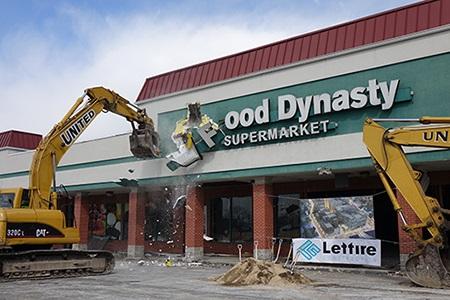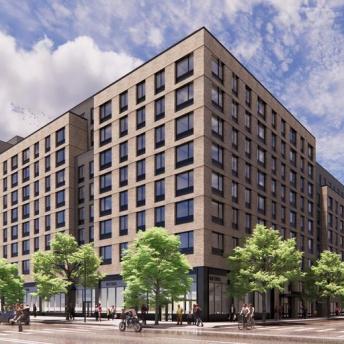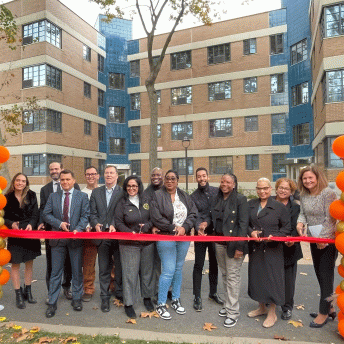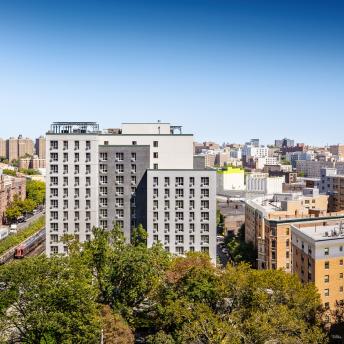QUEENS, NY – The New York City Department of Housing Preservation and Development (HPD) Commissioner Maria Torres-Springer and New York City Housing Development Corporation (HDC) President Eric Enderlin joined City Council Member Donovan Richards and Development Partner Phipps Houses to observe the demolition of the Far Rockaway Shopping Center, a virtually deserted strip mall in Queens that the City is repositioning as a large-scale mixed-use affordable housing development.
“This project exemplifies so much of what we set out to achieve through the Mayor's housing plan. It is not just about creating affordable housing, but investing in our communities to ensure that as the city grows, all areas of the city can thrive. The demolition of this largely-abandoned shopping center, long a blight on the community, ushers in a new era for Downtown Far Rockaway. This first phase of Rockaway Village brings 457 affordable homes to the neighborhood, more than half of which will be permanently affordable through the administration's bold Mandatory Inclusionary Housing policy,” said HPD Commissioner Maria Torres-Springer. “I want to thank Council Member Donovan Richards for his leadership and Phipps Houses and all our private and public partners for their perseverance in advancing this transformational project.”
“This project reflects the vision set forth in the Housing New York plan to revitalize our communities through comprehensive rezonings, to ensure the sustainability of neighborhoods through resilient design, and to secure lasting affordability through programs like Mandatory Inclusionary Housing,” said HDC President Eric Enderlin. “I want to thank all our partners and elected officials for the commitment and hard work that has allowed us to reach this milestone in the redevelopment of Downtown Far Rockaway.”
“The demolition of the Thriftway Mall site is the ultimate symbol of a new day coming to Rockaway,” said Council Member Donovan Richards. “For 40 years, the first thing people saw when they got off the A train at Mott Avenue was complete and utter blight. This site was the epicenter of the lack of investment in the Far Rockaway community, but now we are turning the page to deliver historic levels of opportunity for good jobs, affordable housing, quality retail and necessary infrastructure. I’d like to thank the Downtown Far Rockaway Working Group, Mayor de Blasio, HPD Commissioner Torres-Springer, HDC President Enderlin and Phipps Houses for all of their work to bring this incredible opportunity to Far Rockaway.”
“Phipps Houses is proud to join the Far Rockaway community and the Stark family by offering new vibrant commercial spaces and high-quality affordable housing. This is an exciting new beginning for the heart of Far Rockaway,” said Adam Weinstein, President and CEO of Phipps Houses.
Far Rockaway Village is being developed under HPD’s Mix and Match program. In the first phase, 207 units will be made affordable permanently thanks to the City’s trailblazing Mandatory Inclusionary Housing policy. The 457 newly constructed units will be affordable to extremely low, very low, and low-income households, with 46 units set aside to house formerly homeless families. The first phase of the project is expected to be completed in Winter 2021.
The defunct shopping plaza first opened in the 1930s and eventually fell into disrepair for a number of years. Plans to redevelop the site into affordable housing started in 2016, when Phipps Houses began working with the land owner on a development plan.
In 2017, the City Council approved the Mayor’s plan to rezone Downtown Far Rockaway, which helped to bring $288 million to the community and unlock new mixed-income housing, commercial space, open space, community facilities, and better connections to transportation.
The $271 million development project includes more than $ 130,000,000 in financing from HPD and HDC. HDC provided in total a tax-exempt financing in the amount of $72.2 million. This includes $25.8 million in tax-exempt bonds. There are four phases in total for this project. Future phases are expected to start construction every six to 12 months.
###



